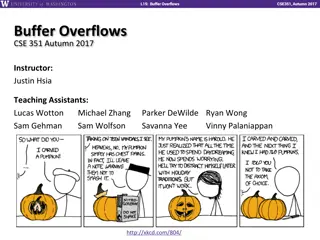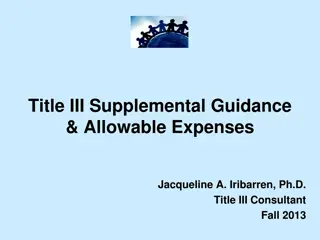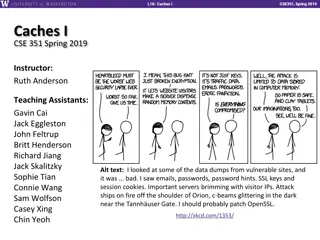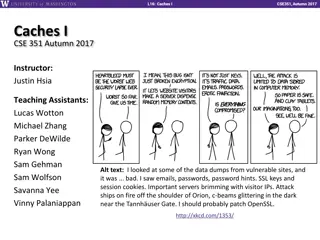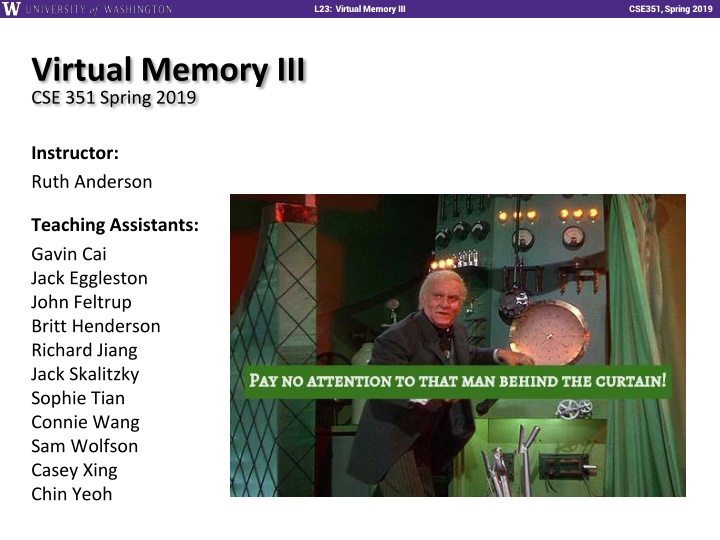
Virtual Memory Address Translation in Computer Science
Explore the concept of virtual memory and address translation in computer science with a focus on page hits, page faults, and ways to optimize memory access. Discover the role of the MMU, CPU cache, page tables, and more in efficiently handling memory requests and translations. Dive into the complexities of memory access and learn about potential solutions to enhance speed and performance.
Download Presentation

Please find below an Image/Link to download the presentation.
The content on the website is provided AS IS for your information and personal use only. It may not be sold, licensed, or shared on other websites without obtaining consent from the author. If you encounter any issues during the download, it is possible that the publisher has removed the file from their server.
You are allowed to download the files provided on this website for personal or commercial use, subject to the condition that they are used lawfully. All files are the property of their respective owners.
The content on the website is provided AS IS for your information and personal use only. It may not be sold, licensed, or shared on other websites without obtaining consent from the author.
E N D
Presentation Transcript
L23: Virtual Memory III CSE351, Spring 2019 Virtual Memory III CSE 351 Spring 2019 Instructor: Ruth Anderson Teaching Assistants: Gavin Cai Jack Eggleston John Feltrup Britt Henderson Richard Jiang Jack Skalitzky Sophie Tian Connie Wang Sam Wolfson Casey Xing Chin Yeoh
L23: Virtual Memory III CSE351, Spring 2019 Administrivia Lab 4, due Fri (5/24) Homework 5 is out! Processes and Virtual Memory Due Friday, May 31 Error on last week s section handout Incorrect variable names for caches 2
L23: Virtual Memory III CSE351, Spring 2019 Address Translation: Page Hit 2 CPU Chip PTEA 1 PTE VA MMU CPU Cache/ Memory 3 PA 4 Data 5 1) Processor sends virtual address to MMU (memory management unit) 2-3) MMU fetches PTE from page table in cache/memory (Uses PTBR to find beginning of page table for current process) 4) MMU sends physical addressto cache/memory requesting data 5) Cache/memory sends data to processor VA = Virtual Address PA = Physical Address PTEA = Page Table Entry Address Data = Contents of memory stored at VA originally requested by CPU PTE= Page Table Entry 4
L23: Virtual Memory III CSE351, Spring 2019 Address Translation: Page Fault Exception Page fault handler 4 2 CPU Chip Victim page PTEA 1 5 VA PTE Cache/ Memory MMU CPU Disk 3 7 New page 6 1) Processor sends virtual address to MMU 2-3) MMU fetches PTE from page table in cache/memory 4) Valid bit is zero, so MMU triggers page fault exception 5) Handler identifies victim (and, if dirty, pages it out to disk) 6) Handler pages in new page and updates PTE in memory 7) Handler returns to original process, restarting faulting instruction 5
L23: Virtual Memory III CSE351, Spring 2019 Hmm Translation Sounds Slow The MMU accesses memory twice: once to get the PTE for translation, and then again for the actual memory request The PTEs may be cached in L1 like any other memory word But they may be evicted by other data references And a hit in the L1 cache still requires 1-3 cycles What can we do to make this faster? Any problem in computer science can be solved by adding another level of indirection. David Wheeler, inventor of the subroutine And all of the new problems that creates can be solved by adding another cache. - Sam Wolfson, inventor of this quote 6
L23: Virtual Memory III CSE351, Spring 2019 Speeding up Translation with a TLB Translation Lookaside Buffer (TLB): Small hardware cache in MMU Maps virtual page numbers to physical page numbers Contains complete page table entries for small number of pages Modern Intel processors have 128 or 256 entries in TLB Much faster than a page table lookup in cache/memory TLB PTE VPN PTE VPN PTE VPN 7
L23: Virtual Memory III CSE351, Spring 2019 TLB Hit TLB PTE VPN PTE VPN PTE VPN CPU Chip TLB PTE 2 3 VPN 1 PA VA MMU CPU Cache/ Memory 4 Data 5 A TLB hit eliminates a memory access! 8
L23: Virtual Memory III CSE351, Spring 2019 TLB Miss TLB PTE VPN PTE VPN PTE VPN CPU Chip TLB 4 2 PTE VPN 1 3 VA PTEA MMU CPU Cache/ Memory PA 5 Data 6 A TLB miss incurs an additional memory access (the PTE) Fortunately, TLB misses are rare 9
L23: Virtual Memory III CSE351, Spring 2019 Fetching Data on a Memory Read 1) Check TLB Input: VPN, Output: PPN TLB Hit: Fetch translation, return PPN TLB Miss: Check page table (in memory) Page Table Hit: Load page table entry into TLB Page Fault: Fetch page from disk to memory, update corresponding page table entry, then load entry into TLB 2) Check cache Input: physical address, Output: data Cache Hit: Return data value to processor Cache Miss: Fetch data value from memory, store it in cache, return it to processor 10
L23: Virtual Memory III CSE351, Spring 2019 Address Translation VM is complicated, but also elegant and effective Level of indirection to provide isolated memory & caching TLB as a cache of page tables avoids two trips to memory for every memory access Virtual Address TLB Lookup TLB Miss TLB Hit Protection Check Check the Page Table Page not in Mem Page in Mem Access Denied Protection Fault Access Permitted Update TLB Physical Address Page Fault (OS loads page) SIGSEGV Find in Disk Find in Mem Check cache 11
L23: Virtual Memory III CSE351, Spring 2019 Simple Memory System Example (small) Addressing 14-bit virtual addresses 12-bit physical address Page size = 64 bytes 13 12 11 10 9 8 7 6 5 4 3 2 1 0 VPN VPO Virtual Page Number Virtual Page Offset 11 10 9 8 7 6 5 4 3 2 1 0 PPN PPO Physical Page Number Physical Page Offset 12
L23: Virtual Memory III CSE351, Spring 2019 Simple Memory System: Page Table Only showing first 16 entries (out of _____) Note: showing 2 hex digits for PPN even though only 6 bits Note: other management bits not shown, but part of PTE VPN 0 1 2 3 4 5 6 7 PPN 28 33 02 16 Valid 1 0 1 1 0 1 0 0 VPN 8 9 A B C D E F PPN 13 17 09 2D 0D Valid 1 1 1 0 0 1 0 1 13
L23: Virtual Memory III CSE351, Spring 2019 Simple Memory System: TLB 16 entries total Why does the TLB ignore the page offset? 4-way set associative TLB tag TLB index 13 12 11 10 9 8 7 6 5 4 3 2 1 0 virtual page number virtual page offset Set Tag PPN Valid Tag PPN Valid Tag PPN Valid Tag PPN Valid 0 03 0 09 0D 1 00 0 07 02 1 1 03 2D 1 02 0 04 0 0A 0 2 02 0 08 0 06 0 03 0 3 07 0 03 0D 1 0A 34 1 02 0 14
L23: Virtual Memory III CSE351, Spring 2019 Note: It is just coincidence that the PPN is the same width as the cache Tag Simple Memory System: Cache Direct-mapped with K = 4 B, C/K = 16 Physically addressed cache tag cache index cache offset 11 10 9 8 7 6 5 4 3 2 1 0 physical page number physical page offset Index 0 1 2 3 4 5 6 7 Tag 19 15 1B 36 32 0D 31 16 Valid 1 0 1 0 1 1 0 1 B0 99 00 43 36 11 B1 11 02 6D 72 C2 B2 23 04 8F F0 DF B3 11 08 09 1D 03 Index 8 9 A B C D E F Tag 24 2D 2D 0B 12 16 13 14 Valid 1 0 1 0 0 1 1 0 B0 3A 93 04 83 B1 00 15 96 77 B2 51 DA 34 1B B3 89 3B 15 D3 15
L23: Virtual Memory III CSE351, Spring 2019 Current State of Memory System Page table (partial): VPN PPN V 0 28 1 1 0 2 33 1 3 02 1 4 0 5 16 1 6 0 7 0 TLB: VPN PPN 8 9 A B C D E F V 1 1 1 0 0 1 0 1 Set Tag PPN 0 03 1 03 2 02 3 07 V 0 1 0 0 Tag PPN 09 02 08 03 V 1 0 0 1 Tag PPN 00 04 06 0A V 0 0 0 1 Tag PPN 07 0A 03 02 V 1 0 0 0 13 17 09 2D 0D 0D 0D 02 2D 34 Cache: Index 0 1 2 3 4 5 6 7 Tag 19 15 1B 36 32 0D 31 16 V 1 0 1 0 1 1 0 1 B0 99 00 43 36 11 B1 11 02 6D 72 C2 B2 23 04 8F F0 DF B3 11 08 09 1D 03 Index 8 9 A B C D E F Tag 24 2D 2D 0B 12 16 13 14 V 1 0 1 0 0 1 1 0 B0 3A 93 04 83 B1 00 15 96 77 B2 51 DA 34 1B B3 89 3B 15 D3
L23: Virtual Memory III CSE351, Spring 2019 Note: It is just coincidence that the PPN is the same width as the cache Tag Memory Request Example #1 Virtual Address: 0x03D4 TLBT 13 12 11 TLBI 10 9 8 7 6 5 4 3 2 1 0 0 0 0 0 1 1 1 1 0 1 0 1 0 0 VPN VPO VPN ______ TLBT _____ TLBI _____ TLB Hit? ___ Page Fault? ___ PPN _____ Physical Address: CO CI CT 11 10 9 8 7 6 5 4 3 2 1 0 PPN PPO CT ______ CI _____ CO _____ Cache Hit? ___ Data (byte) _______ 17
L23: Virtual Memory III CSE351, Spring 2019 Note: It is just coincidence that the PPN is the same width as the cache Tag Memory Request Example #2 Virtual Address: 0x038F TLBT 13 12 11 TLBI 10 9 8 7 6 5 4 3 2 1 0 0 0 0 0 1 1 1 0 0 0 1 1 1 1 VPN VPO VPN ______ TLBT _____ TLBI _____ TLB Hit? ___ Page Fault? ___ PPN _____ Physical Address: CO CI CT 11 10 9 8 7 6 5 4 3 2 1 0 PPN PPO CT ______ CI _____ CO _____ Cache Hit? ___ Data (byte) _______ 18
L23: Virtual Memory III CSE351, Spring 2019 Note: It is just coincidence that the PPN is the same width as the cache Tag Memory Request Example #3 Virtual Address: 0x0020 TLBT 13 12 11 TLBI 10 9 8 7 6 5 4 3 2 1 0 0 0 0 0 0 0 0 0 1 0 0 0 0 0 VPN VPO VPN ______ TLBT _____ TLBI _____ TLB Hit? ___ Page Fault? ___ PPN _____ Physical Address: CO CI CT 11 10 9 8 7 6 5 4 3 2 1 0 PPN PPO CT ______ CI _____ CO _____ Cache Hit? ___ Data (byte) _______ 19
L23: Virtual Memory III CSE351, Spring 2019 Note: It is just coincidence that the PPN is the same width as the cache Tag Memory Request Example #4 Virtual Address: 0x036B TLBT 13 12 11 TLBI 10 9 8 7 6 5 4 3 2 1 0 0 0 0 0 1 1 0 1 1 0 1 0 1 1 VPN VPO VPN ______ TLBT _____ TLBI _____ TLB Hit? ___ Page Fault? ___ PPN _____ Physical Address: CO CI CT 11 10 9 8 7 6 5 4 3 2 1 0 PPN PPO CT ______ CI _____ CO _____ Cache Hit? ___ Data (byte) _______ 20
L23: Virtual Memory III CSE351, Spring 2019 Memory Overview movl 0x8043ab, %rdi Disk Page requested 32-bits Main memory (DRAM) CPU Cache Page Line Block MMU TLB 21
L23: Virtual Memory III CSE351, Spring 2019 This is extra (non-testable) material Page Table Reality Just one issue the numbers don t work out for the story so far! The problem is the page table for each process: Suppose 64-bit VAs, 8 KiB pages, 8 GiB physical memory How many page table entries is that? About how long is each PTE? Moral: Cannot use this na ve implementation of the virtual physical page mapping it s way too big 22
L23: Virtual Memory III CSE351, Spring 2019 This is extra (non-testable) material A Solution: Multi-level Page Tables This is called a page walk Page table base register (PTBR) Virtual Address n-1 p-1 0 ... VPN k VPN 1 VPN 2 VPO Level k page table Level 2 page table Level 1 page table ... ... PPN m-1 p-1 0 TLB PPN PPO PTE VPN Physical Address PTE VPN PTE VPN 23
L23: Virtual Memory III CSE351, Spring 2019 This is extra (non-testable) material Multi-level Page Tables A tree of depth ? where each node at depth ? has up to 2? children if part ? of the VPN has ? bits Hardware for multi-level page tables inherently more complicated But it s a necessary complexity 1-level does not fit Why it works: Most subtrees are not used at all, so they are never created and definitely aren t in physical memory Parts created can be evicted from cache/memory when not being used Each node can have a size of ~1-100KB But now for a ?-level page table, a TLB miss requires ? + 1 cache/memory accesses Fine so long as TLB misses are rare motivates larger TLBs 24
L23: Virtual Memory III CSE351, Spring 2019 Practice VM Question Our system has the following properties 1 MiB of physical address space 4 GiB of virtual address space 32 KiB page size 4-entry fully associative TLB with LRU replacement a) Fill in the following blanks: ________ Entries in a page table ________ Minimum bit-width of page table base register (PTBR) ________ TLBT bits ________ Max # of valid entries in a page table 25
L23: Virtual Memory III CSE351, Spring 2019 Practice VM Question One process uses a page-aligned 2048 2048square matrix mat[] of 32-bit integers in the code shown below: #define MAT_SIZE = 2048 for(int i = 0; i < MAT_SIZE; i++) mat[i*(MAT_SIZE+1)] = i; b) What is the largest stride (in bytes) between successive memory accesses (in the VA space)? 26
L23: Virtual Memory III CSE351, Spring 2019 Practice VM Question One process uses a page-aligned 2048 2048square matrix mat[] of 32-bit integers in the code shown below: #define MAT_SIZE = 2048 for(int i = 0; i < MAT_SIZE; i++) mat[i*(MAT_SIZE+1)] = i; Assuming all of mat[] starts on disk, what are the following hit rates for the execution of the for-loop? c) ________ TLB Hit Rate ________ Page Table Hit Rate 27
L23: Virtual Memory III CSE351, Spring 2019 For Fun: DRAMMER Security Attack BONUS SLIDES Why are we talking about this? Recent(ish): Announced in October 2016; Google released Android patch on November 8, 2016 Relevant:Uses your system s memory setup to gain elevated privileges Ties together some of what we ve learned about virtual memory and processes Interesting:It s a software attack that uses only hardware vulnerabilities and requires no user permissions 28
L23: Virtual Memory III CSE351, Spring 2019 Underlying Vulnerability: Row Hammer Dynamic RAM (DRAM) has gotten denser over time DRAM cells physically closer and use smaller charges More susceptible to disturbance errors (interference) DRAM capacitors need to be refreshed periodically (~64 ms) Lose data when loss of power Capacitors accessed in rows Rapid accesses to one row can flip bits in an adjacent row! ~ 100K to 1M times By Dsimic (modified), CC BY-SA 4.0, https://commons.wikimedia.org/w /index.php?curid=38868341 29
L23: Virtual Memory III CSE351, Spring 2019 Row Hammer Exploit Force constant memory access Read then flush the cache clflush flush cache line hammertime: mov (X), %eax mov (Y), %ebx clflush (X) clflush (Y) jmp hammertime Invalidates cache line containing the specified address Not available in all machines or environments Want addresses X and Y to fall in activation target row(s) Good to understand how banks of DRAM cells are laid out The row hammer effect was discovered in 2014 Only works on certain types of DRAM (2010 onwards) These techniques target x86 machines 30
L23: Virtual Memory III CSE351, Spring 2019 Consequences of Row Hammer Row hammering process can affect another process via memory Circumvents virtual memory protection scheme Memory needs to be in an adjacent row of DRAM Worse: privilege escalation Page tables live in memory! Hope to change PPN to access other parts of memory, or change permission bits Goal: gain read/write access to a page containing a page table, hence granting process read/write access to all of physical memory 31
L23: Virtual Memory III CSE351, Spring 2019 Effectiveness? Doesn t seem so bad random bit flip in a row of physical memory Vulnerability affected by system setup and physical condition of memory cells Improvements: Double-sided row hammering increases speed & chance Do system identification first (e.g. Lab 4) Use timing to infer memory row layout & find bad rows Allocate a huge chunk of memory and try many addresses, looking for a reliable/repeatable bit flip Fill up memory with page tables first fork extra processes; hope to elevate privileges in any page table 32
L23: Virtual Memory III CSE351, Spring 2019 What s DRAMMER? No one previously made a huge fuss Prevention: error-correcting codes, target row refresh, higher DRAM refresh rates Often relied on special memory management features Often crashed system instead of gaining control Research group found a deterministic way to induce row hammer exploit in a non-x86 system (ARM) Relies on predictable reuse patterns of standard physical memory allocators Universiteit Amsterdam, Graz University of Technology, and University of California, Santa Barbara 33
L23: Virtual Memory III CSE351, Spring 2019 DRAMMER Demo Video It s a shell, so not that sexy-looking, but still interesting Apologies that the text is so small on the video 34
L23: Virtual Memory III CSE351, Spring 2019 How did we get here? Computing industry demands more and faster storage with lower power consumption Ability of user to circumvent the caching system clflush is an unprivileged instruction in x86 Other commands exist that skip the cache Availability of virtual to physical address mapping Example:/proc/self/pagemap on Linux (not human-readable) Google patch for Android (Nov. 8, 2016) Patched the ION memory allocator 35
L23: Virtual Memory III CSE351, Spring 2019 More reading for those interested DRAMMER paper: https://vvdveen.com/publications/drammer.pdf Google Project Zero: https://googleprojectzero.blogspot.com/2015/03/exp loiting-dram-rowhammer-bug-to-gain.html First row hammer paper: https://users.ece.cmu.edu/~yoonguk/papers/kim- isca14.pdf Wikipedia: https://en.wikipedia.org/wiki/Row_hammer 36










